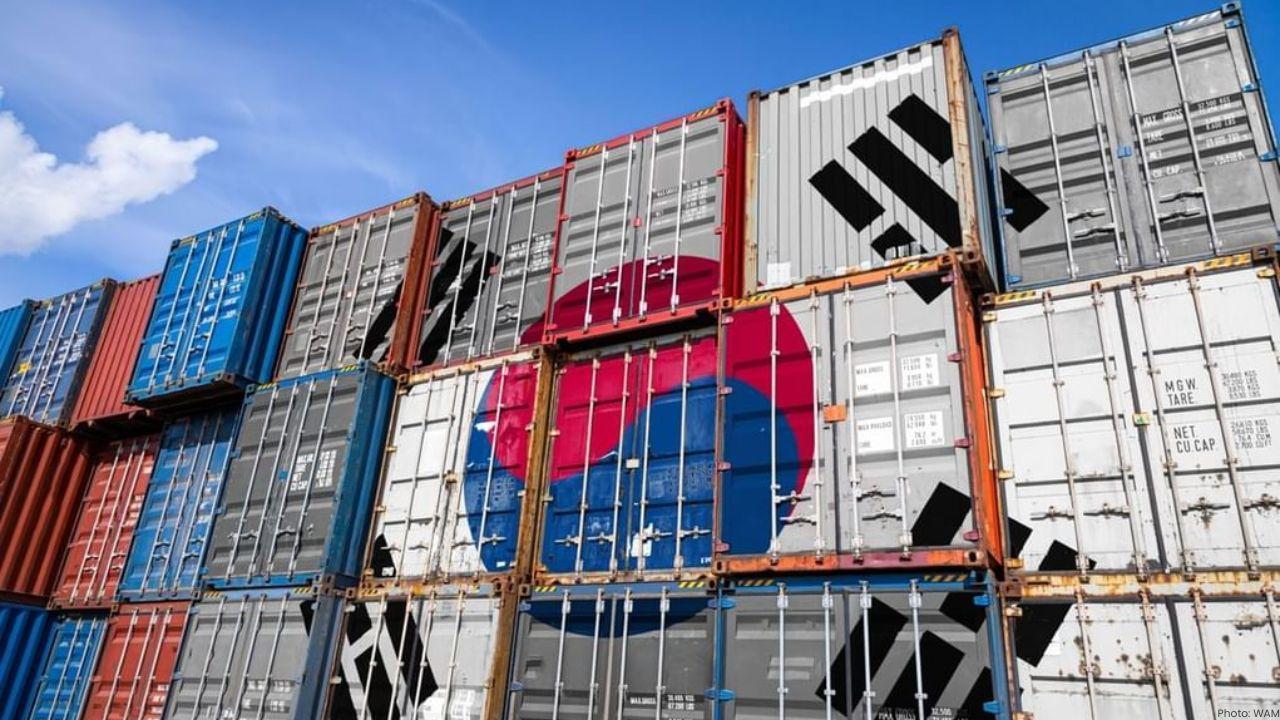
Post by : Layla Badr
South Korea, officially known as the Republic of Korea, has reported an increase in its exports during the first ten days of September. The data, released by the Korea Customs Service on Thursday, shows that outbound shipments rose by 3.8 percent compared to the same period last year. This growth was largely driven by strong demand for semiconductors and vessels, two of South Korea’s major export products.
Exports reached a total value of $19.2 billion between September 1 and 10, which is higher than the $18.5 billion recorded in the same period last year. Despite this overall increase, analysts pointed out that the daily average volume of exports actually fell by 8.7 percent compared to the previous year. This suggests that while total exports are higher, the pace of shipments per day has slowed, reflecting some underlying challenges in trade flows.
Stay informed with the latest news. Follow DXB News Network on WhatsApp Channel
Key Drivers of Export Growth
South Korea’s export growth in early September was supported mainly by semiconductors and ships. Semiconductors are tiny chips used in almost all electronic devices, including computers, smartphones, and cars. Demand for these chips has remained steady in global markets, helping South Korea maintain its position as one of the world’s leading semiconductor exporters.
Vessels, including ships and other maritime equipment, also contributed to the export increase. South Korea is known for its shipbuilding industry, which produces large container ships, oil tankers, and specialized vessels. The global shipping industry’s ongoing recovery after the pandemic has created strong demand for new ships, which has benefited South Korean exporters.
Imports Show Strong Increase
While exports rose, imports increased at an even faster pace. According to the Korea Customs Service, imports jumped by 11.1 percent on a year-on-year basis, reaching $20.4 billion during the first ten days of September. This sharp increase in imports is likely due to South Korea’s need for raw materials, industrial components, and energy resources to support its manufacturing and technology sectors.
The combination of higher imports and slower daily export growth resulted in a trade deficit of $1.2 billion for the period. A trade deficit occurs when a country imports more goods and services than it exports. While trade deficits are not unusual, they can indicate that a country is spending more on foreign goods than it earns from selling its products abroad.
Comparison with August Trade Figures
In August, South Korea’s exports had grown by 1.3 percent compared to the same month last year, reaching a total of $58.4 billion. The growth in August was mainly attributed to strong global demand for semiconductors. This shows that while the growth rate in early September is higher than in August, there are still challenges in sustaining consistent export momentum.
The slight increase in August’s exports, followed by a larger increase in early September, indicates that South Korea’s economy continues to benefit from global demand for its key products, particularly in the technology and shipbuilding sectors.
Daily Export Volume Decline
One of the interesting points from the recent data is the decline in the daily average export volume by 8.7 percent on a yearly basis. This means that although total exports have increased, the number of goods shipped per day has fallen. Experts suggest that this could be due to factors such as supply chain disruptions, changes in international shipping schedules, or fluctuations in demand for certain products.
A decline in daily export volume is important because it reflects the pace of trade activity. Even if total exports are rising, a slower daily rate can signal that the economy may face challenges in maintaining strong growth over time.
Trade Balance and Economic Implications
South Korea’s trade deficit of $1.2 billion in early September is a point of attention for economists and policymakers. A trade deficit is not necessarily negative, as it can indicate strong domestic demand for foreign goods and investment. However, prolonged deficits can affect the country’s foreign exchange reserves and influence the value of its currency.
In South Korea’s case, the deficit is relatively small compared to the country’s total trade volume, suggesting that the economy remains strong. The government may monitor the situation closely and take measures to ensure that exports continue to grow while managing import levels effectively.
Global Market Context
South Korea’s export performance is closely linked to global economic trends. Strong demand for semiconductors, ships, and other key products reflects the ongoing recovery in global trade after disruptions caused by the COVID-19 pandemic. Many countries are increasing their investments in technology, infrastructure, and industrial equipment, which benefits South Korean exporters.
At the same time, challenges such as rising energy prices, shipping delays, and geopolitical tensions can affect trade flows. South Korea’s ability to navigate these challenges while maintaining steady export growth will be critical in sustaining economic stability.
Government and Industry Response
The South Korean government and business community are likely to continue focusing on supporting key export industries. Measures may include incentives for semiconductor manufacturers, support for shipbuilders, and initiatives to diversify export markets. Strengthening trade relations with other countries can also help reduce risks associated with over-reliance on specific markets.
Industry experts emphasize that innovation and competitiveness are crucial for South Korea’s export success. The country has maintained a strong position in technology, shipbuilding, and heavy industries through continuous investment in research and development, skilled labor, and high-quality production standards.
Outlook for the Coming Months
Looking ahead, South Korea’s trade performance in September and beyond will depend on several factors, including global demand for semiconductors, shipping trends, and economic conditions in key markets such as the United States, China, and Europe. Analysts expect that exports may continue to grow moderately, but the trade deficit could persist if imports rise faster than exports.
Policymakers may also monitor currency fluctuations and global supply chain developments to ensure that South Korea remains competitive in international trade. A balanced approach that encourages exports while managing imports and domestic consumption will be essential for sustainable economic growth.
South Korea’s exports rose by 3.8 percent in the first ten days of September, driven by strong demand for semiconductors and vessels. Exports reached $19.2 billion, compared with $18.5 billion a year earlier. Imports increased 11.1 percent to $20.4 billion, resulting in a trade deficit of $1.2 billion.
While the overall growth in exports is a positive sign, the decline in daily average export volume highlights challenges in maintaining consistent trade momentum. The government, industries, and businesses will continue to focus on strengthening exports, supporting key sectors, and navigating global economic uncertainties.
South Korea’s trade performance reflects both its strengths as a leading exporter of technology and vessels, and the ongoing challenges of managing imports and global market fluctuations. The coming months will show whether the country can sustain steady export growth while keeping its trade balance in check.

UAE’s Noura Al Kaabi Highlights Openness at Monocle Forum
UAE Minister Noura Al Kaabi stresses dialogue, coexistence, and cultural exchange as keys to global

Tamannaah Bhatia stuns in green dress, wows fans online
Tamannaah Bhatia wows fans with her weight loss and stunning green dress. See her latest fashion mom

Sleep Hygiene Simple and Effective Tips for a Better Night s Sleep
Learn simple sleep hygiene tips to fall asleep faster sleep better and wake up refreshed with more

Priyanka Chopra & Nick Jonas Shine in Brown at NYFW 2025
Priyanka Chopra and Nick Jonas stun in brown monochrome looks at Ralph Lauren’s NY Fashion Week 2025

Fitness at Home Simple Ways to Stay Healthy Without the Gym
Stay active at home with simple workouts Save time boost energy and stay healthy without needing

Nepal Officials Escape Mob Using Emergency Helicopter Rope
Nepal’s senior officials flee angry protesters by hanging onto helicopter ropes amid rising unrest,

Air India Flight to Singapore Delayed, Passengers Stranded
Over 200 Air India passengers faced delay at Delhi airport after sitting for 2 hours in faulty AC. F

Israel Launches Airstrikes on Yemen — 35 Dead, Over 130 Injured in Sanaa and Al Jawf
Emergency teams rush to rescue survivors as strikes hit military sites, fuel depots, and residential

Charlie Kirk Shot Dead at Utah University During Speech
Charlie Kirk, Turning Point USA founder, was shot dead at Utah Valley University. Chaos erupted as t

Barakah Nuclear Plant Completes One Year of Full UAE Power Supply
Barakah Nuclear Plant marks one year of full operations, providing 25% of UAE electricity and cuttin

GCC launches unified 2025 guideline to boost investor relations
A new GCC-wide 2025 Investor Relations Guideline aims to unify practices, strengthen transparency an

UAE and Fiji explore new paths of cooperation in key growth areas
A UAE delegation visited Fiji to boost ties in economy education sports and climate action, highligh

Sharjah boosts India tourism links with 2025 Mumbai Delhi roadshow
Sharjah concluded its India roadshow in Mumbai and Delhi, signing key deals, promoting tourism and r

Umm Al Qaiwain Unveils New Tourism Identity for Global Growth
Umm Al Qaiwain launches new identity to boost tourism, highlight heritage and attract global investm

Ras Al Khaimah Ruler meets Botswana President to boost ties
Ras Al Khaimah Ruler welcomed Botswana’s President to discuss stronger ties, economic cooperation an